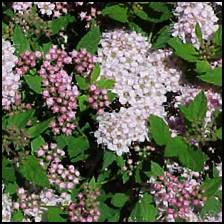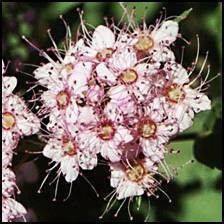
Spiraea
SCIENTIFIC NAME:(Spiraea (Each variety having a different name))
Spiraea is a genus of about 80-100 species of shrubs in the family Rosaceae. They are native to the temperate Northern Hemisphere, with the greatest diversity in eastern Asia.
Spiraea plants are hardy, deciduous-leaved shrubs. The leaves are simple and usually short stalked in an alternate (i.e. spiral) arrangement. In most species, the leaves are narrowly oval and about 1 to 4 inches (2.5 to 10 cm) long. The leaf margins are usually toothed, occasionally cut or lobed, and rarely smooth. Stipules are absent.
The many small flowers of Spiraea shrubs are clustered together forming an umbrella-like or grape-like cluster. The radial symmetry of each flower is five-fold, with the flowers usually bisexual, rarely unisexual. The flowers have five sepals and five white, pink, or reddish petals that are usually longer than the sepals. Each flower has many (15 to 60) stamens.
Common Names:

Uses:
Spiraea is too woody to be used as an edible plant, but has a long history of medicinal use by Native Americans as an herbal tea.Spiraea shrubs contain methyl salicylate (oil of wintergreen) and other salicylates throughout the plant, compounds with similar medicinal properties to aspirin. Unlike such other salicylate-bearing plants as Willow (Salix) or Poplar (Populus), Spiraea's content of these analgesic compounds appears to be consistent from plant to plant. The salicylates in this plant are considered to be highly effective as an analgesic, anti-inflammatory, and fever reducer, without the side effects attributed to aspirin. Unlike aspirin, Spiraea is effective in treating stomach disorders in minute amounts.
Certain compounds in this plant also have bacteriostatic properties. The tea of this plant was used by the Blackfeet Indians as an enema and vagina douche to treat infections of the bowels and vaginal area.
Applications:
Tea:
Use leaves, roots and or flowers to brew tea. Allow to steep for 15 minutes. Drink 1 to 4 cups per day for pain relief.
Warnings:
Many kinds of plants produce methyl salycylate, and it is also easily synthesized industrially. While useful as a flavoring or medicinal in small quantities, larger amounts (from any source) can be hazardous or fatal.
With any herb, there is the risk of an allergic reaction. Small children and pregnant women should use additional caution when considering the use of herbal remedies.





